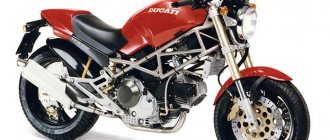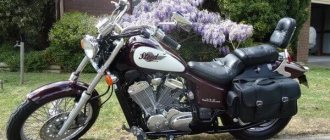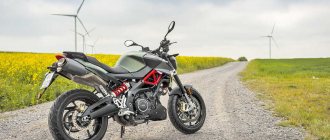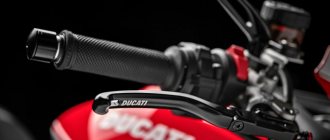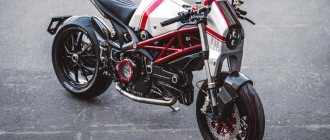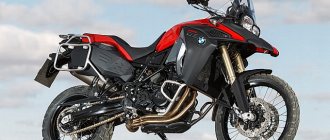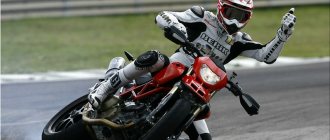MY MOTORCYCLE
According to the canons of the Church of the Flying Spaghetti Monster*, this particular model is considered the entry model, and not the even more budget Scrambler. Well, as one movie character said, “let’s see what kind of Sukhov he is”: a small but real Ducati or a low-cost improvisation on the theme of the Monster 1200?
To begin with, I will briefly list the differences between the M821 and the “big Monster” model 1200. So, this is a motor with a smaller dimension (88.0 × 67.5 instead of 106.0 × 67.9) and power, as well as a simplified design (crankshaft with a smaller diameter journals; cable rather than hydraulic clutch release, simpler design of throttle units...), non-adjustable suspensions - and a double-armed, rather than cantilever, pendulum of shorter length (and, accordingly, a 31 mm smaller base and 10 mm less suspension travel). And also - a black and white display (there are no indicators for gears or fuel level, just like on the 1200 - except for R). Another point is that the number is on the rear wing, not on the swingarm. Well, the differences between the cheaper version of Dark are the painting with black matte varnish (easily scratched, by the way - obviously in anticipation of further repainting by the owner) and the absence of an “antibody” that I personally don’t need at all.
And immediately - the first associations with former style icons. The tank is reminiscent of the last (I hope and believe that not the last) generation SS, with its swells, but otherwise the driving experience is similar to the previous generation Monster. The same position with your head above the wheel, the same position of your legs - but how much more pleasant it is to feel your knees not on pliable plastic, like the previous “monsters”, but on a steel tank! The current saints of Pastafarianism may not shine with their former beauty, but they are much less prone to plasticity. The tank tilts back again (only secured with an elastic band, not a latch lock) back, and is not dismantled after unscrewing 16 screws. It's just the cable release of the clutch... more precisely, the feeling on the lever... alas and ah. However, what should be considered a classic - the hydraulic squeezing of the “cracker” or this solution, originally used on the founder of the “belt” L2, the Pantah 500 of ’79?
A cable clutch release was installed on the first, 350 and 500 cc versions of the distant ancestor - the Ducati Pantah.
The first kilometers - and the analogies with its predecessors only intensify. Yes, the M821 is larger and heavier than the M696 and a third more powerful - but adjusted for scale, the sensations are the same. Equally comfortable suspension, equally pleasant and relaxed steering; At the same time, unlike many competitors, the rake does not tend to zero, which does not create a feeling of emptiness in the steering wheel when taxiing between the rows. And the same as the 696, the need to constantly unscrew the handle! At 7 thousand, the engine fires with all its heart - unless, of course, you forget to switch the electronic throttle mode from Touring to Sport, which by default also minimizes the interference of traction and automatic braking. Another half hour of intensive maneuvering in traffic - and you are already openly rude, flying into any traffic holes and overtaking anyone in vain. Hooligan device! The brakes are not top-end M50, but better than those of its competitors, the frame and swingarm are sufficient, the engine is even more so (112 forces is not enough in traffic? Well, well...), and the suspension allows you to sail over potholes in the most comfortable way.
Is your appearance not Italian? If only we “forget” that not all Ducati (and also Laverda, Moto Guzzi, Cagiva...) were aimed at being masterpieces, to say the least!
But the pasta grace fades with increasing speed, and the comfortable settings of the fork and shock absorber can go sideways. God forbid you get carried away and start trudging through an empty city at night - say, by hanging out with sport bikers or deciding to run away from an expensive motorcycle battalion. The engine here is enough for 160+, but the suspension is not enough. More precisely, “slow” damping. As a result, jumping from lane to lane over crushed ruts, you soon catch a longitudinal swing. And not hard buffeting, like, say, on the SF1098 (at least you know how to deal with it, almost without slowing down), but rather a smooth swing, making following the trajectory difficult and forcing you to helplessly slow down... And although the engine allows you to go 220 s tail, and the oncoming flow unloads the front only after 210 (much later, when it becomes unbearable to hold your torso and neck - the tank is aerodynamically active here) - I recommend doing this only on a completely flat and relatively straight road.
Including the passenger. If the previous Monsters were more like one-and-a-half-seaters than two-seaters, then here your “captive” will be, if not comfortable (tea, not an “electric train”), then quite comfortable. Even if she is by no means an inch and at first is seriously worried about the increased windage of her meter eighty without cables. However, in any case, she will have to change the cables to motorcycle boots or at least martens - the muffler is too close to the passenger’s right foot. And you should switch the engine from Sport to Touring so that the response to the handle is softer, as are the traction settings. After which - forward and with a song. The passenger seat is soft, the weight distribution of the car is spoiled uncritically - so ride as much as you like.
High heels and skirts are contraindicated for passengers: the muffler is in the immediate vicinity of the right rear step.
Ladies will especially like the saddle. Passengers - the convenience of the rear. For drivers - the ability to adjust the height.
So is it Ducati or not? Definitely yes. The Flying Pasta Monster - although it flies lower than the “1200” and, even more so, the legendary S4RS, is still faster than both the 696 and the 1100. Yes, in comparison with the 1200 (which I drove a lot soon), our hero lacks stability on the straights, the cable clutch release, as well as the simple instrumentation, make the workplace cheaper, and the fussy nature of the “twisting” engine with a light flywheel has nothing in common with the rich “middle” and more powerful “big brother”. But, unlike the M1200, the motorcycle creates a feeling of balance between the chassis and engine, encourages aggressive behavior in traffic - and does not frighten you with rolliness in corners. And thanks to this, 821 is quite capable of outperforming its older brother in a real city.
A wonderful car - especially if you paint it brighter. To adequately celebrate the main holiday of Pastafarians - Friday.
Ramin!
Bottom line
As expected, this is a machine with a completely different purpose than the Scrambler. Not an addition to the Multistrada, Panigale or Youngtimer - but a universal (well, almost...) motorcycle for those who want a Ducati, and certainly new. In short, for beginners, but already convinced, adherents of the Pastafarian church. And this is a real Ducati - a direct successor to the M696 and its ancestor Pantah. For complete happiness, the only thing missing is the version with a semi-fairing. But it won't be Monster anymore. However, the style of this generation of “little monsters” is very far from the first-born of Galuzzi’s work - and the habits of the M821 have nothing in common with it. As with its older, 1200 cc brother.
Equipment provided by mototouring.ru.
Issue: MOTO Magazine - February 2016
Author: .Stinger, photo by Alexander BATYRU
Ducati Monster 821 – TEST
2015 onwards, 821 cm3, 112 l. pp., 205.5 kg, 10,490 €
text: Alexander Barkalov photo: Milagro
in the photo: Alexander Barkalov
“To see with my own eyes exactly how the new Monster turned out, I went to the homeland of Ducati motorcycles - Bologna, where the world premiere of the new product was held for the press.
Genes More than 20 years ago, Ducati introduced the first model of the Monster family, creating a real revolution in the motorcycle industry. Since then, more than 290,000 Italian naked bikes have been sold worldwide, and each of their owners has contributed to the development of the model, making the Ducati Monster a true icon, independent of the laws of time. Combining unique design and high technology, Monster series devices continue to be a symbol of style and uniqueness. The new 821st “Monster” was no exception. Designed to replace the 796th modification in the manufacturer’s model range, the new member of the large Italian family is quite distanced from its predecessor, since it was created with an eye on the Monster 1200 and borrows many components from its “big brother”. The new product differs from the Monster 796, which debuted in 2011, in literally every detail, so the 821 model can be confidently spoken of as a radically new development from the factory. Global changes affected not only all technical aspects of the motorcycle, but also affected one of its strongest sides - design. The frame has grown in size, capable of accommodating the Testastretta 11° engine, an intricately shaped fuel tank, a shortened “tail” and mufflers that have moved to the right side - all this has made the appearance of the device more collected and muscular. From a stylish naked bike, the motorcycle has turned into a real urban street fighter, radiating aggression even while standing in the parking lot.
It is quite natural that the changes made to the motorcycle also affected the ergonomics of the driver's seat. For example, the handlebar position on the Ducati Monster 821 is 40mm closer and 40mm higher than it was on the 796. The seat has also changed quite a bit. Firstly, the thickness of the filler has increased by 10 mm, and the platform itself has become 27 mm longer and 34 mm wider. Secondly, already in the factory configuration, the new “Monster” is equipped with a height-adjustable seat (from 785 to 810 mm). Taken together, all this allows a driver of almost any height and build to sit comfortably behind the wheel of the new Ducati. Perhaps the only ergonomic mistake is the position of the driver's footrests, due to which the right motorcycle boot inevitably comes into contact with the hot exhaust system. Otherwise, the “workplace” of the owner of the Monster 821 can be considered impeccably thought out and incredibly comfortable.
Fierce When choosing an engine for the new naked bike, Ducati engineers did not invent anything new: the latest version of the proven Testastretta 11° engine, which was first installed on the Hypermotard and Hyperstrada models in 2013, instead of the old 2-valve, was chosen as the power plant for the Monster 821 model. air balloon." Specifically for the dimensions of the engine, the Ducati design bureau developed a new unit, which is usually called the frame. The remnant birdcage, once the family's calling card, is made from steel tubing and bolts directly to the cylinder heads, just like on a Monster 1200 or Panigale. According to the manufacturer, the new frame not only became 99% stiffer in torsion and 67% stiffer in bending, but also lost 1.23 kg. In turn, the steel subframe has also become lighter, shedding 1.1 kg. Especially for the new “Monster,” the 821 cc L-Twin was “pissed off” a little, adding two horsepower on top, bringing the total number to 112 units. At the same time, the torque figure remains unchanged: as before, at 7,750 rpm the Testastretta 11° produces 89.4 Nm. If we continue to compare the characteristics of the new motorcycle with the performance of its predecessor, the increase in power is an impressive 25 hp. s., and the torque increased by 10.8 Nm. In addition, the company’s specialists were faced with the task of achieving smoother power delivery at low speeds than was the case on the Hypermotard and Hyperstrada. This was achieved by installing a new block of throttle valves with a diameter of 53 mm directly into the original air filter box - with a slight loss in the upper rev range, this operation resulted in extremely juicy “bottoms” and “mids”.
Like all the latest models from Borgo Panigale, the engine of the new Monster 821 is capable of operating in three different modes: Urban, Touring, Sport. During a road test, which took place in the southern outskirts of Bologna, I tried the “urban” mode only once, after which it was forgotten forever. In general, driving using Urban mode, where engine power is reduced to 75 hp. pp., and the degree of control of electronic assistants reaches almost the maximum level, is a very dubious pleasure. The engine's response to opening the throttle is as slow as a line of pensioners at the post office, and the traction control tries to work even before leaving the parking lot. In Touring mode, the L-shaped “two” is transformed. Thanks to smart electronics, the connection between the throttle and throttle body feels as natural as a cable drive. The engine is extremely tractable and controlled, delivering maximum power smoothly and demonstrating the ability to accelerate the bike quickly while maintaining torque flow at all rpms. Already in the “middle” of the operating range, the Testastretta 11° demonstrates performance close to maximum, which allows you to accelerate quite dynamically on the Italian naked bike, without driving the electronic “snake” of the tachometer into the red zone.
The Sport mode is not much different from the “Touring” mode: the power is the same, except that the reactions to the operation of the gas handle are slightly aggravated, plus the presence of the ubiquitous proprietary Ducaty Safety Pack weakens (8-level DTC traction control and 3-mode ABS Bosch 9MP) . Perhaps the most obvious drawback of the 821 cc engine, which was noted by all colleagues, is the excess heat generated by the power plant. Due to the design of the exhaust system, engine heat is especially felt on the right side of the motorcycle. On a 30-degree afternoon, standing at a traffic light waiting for the green light, you begin to involuntarily “flow” onto the left side of the Monster, trying to avoid the fate of being smoked alive. However, the excessive ardor of the new naked car can easily be forgiven for the sound of the exhaust system alone! Stylish upward-facing mufflers produce such a deep and rich “sound” that the right hand is looking for an opportunity not to cover the throttle longer. To the accompaniment of slight engine vibrations and rolling thunder from the mufflers, you can leisurely roll along quiet city streets or rush along the arrow of the autobahn, feeling like the rider of a ferocious centaur. In both situations, the feeling of piloting is indescribable.
Delight As I enthusiastically accelerated on short straights and dashed into the blind corners of the winding mountain roads around Italy's longest A1 motorway, I gradually began to understand what it was that I liked so much about the new Ducati naked. The composure of the chassis and its predictable behavior in any situation is what makes you literally fall in love with this little “Italian”! The behavior of the motorcycle on the road is as simple and clear as it is precise and confident.
A simple Kayaba fork with stays with a diameter of 43 mm and completely devoid of adjustments works well on the road surface, while giving clear and intelligible feedback. The Sachs rear shock absorber, although equipped with adjustments, is tailored for the average rider and is slightly oriented towards comfort. Despite the very low-cost suspension for such an expensive motorcycle, Italian specialists managed to achieve an amazing balance between comfort and refined handling. Every time you push the Monster 821 into a corner, you're surprised at how responsive the bike is. Any command, be it a trajectory adjustment, a change in the angle of inclination or an instant change of direction, is executed unquestioningly. And then the understanding comes that you are already waiting for the next sharp turn with excitement, and your heart begins to beat more and more often with delight. The only thing you can try to blame the chassis of the new Monster for is the loss of charm: the classic pendulum is noticeably inferior to the console one in terms of aesthetics. The naked brakes also deserve praise: 4-piston Brembo M4-32 calipers frantically bite into 320 mm discs under the watchful gaze of Bosch ABS 9MP electronics, forcing the 200-kilogram motorcycle to quickly settle. Ducati claims that compared to the Monster 796, the new model's braking efficiency is approximately 14-25% higher, depending on the applied force! The rear brake “circuit” on the motorcycle is also very effective, but the brake pedal is located a little low.
The main target audience of the Ducati Monster 821 in Bologna is seen as owners of “Monsters” of previous generations, owners of naked bikes from competing companies, as well as novice riders and women. We can only partially agree with the last two points. I am sure that due to its lower power, weight and seat height, the Monster 696 model is much better suited to this target audience. The 821, in turn, can be an ideal means of enjoyment for the more experienced pilot. A competitive power-to-weight ratio, exciting handling and the presence of modern electronic assistants, coupled with ease of daily use, make the new Monster extremely attractive in the eyes of many buyers. One cannot discount the magnificent Italian design, modern, but at the same time managing to preserve the family features inherent in all generations of naked bikes from Bologna. Largely due to their unique appearance, representatives of the Monster family have remained true style icons in the industry for 20 years. And the new Ducati Monster 821 is no exception. /
Tags
Ducati
Horse and doe
“You cannot harness a horse and a tremulous doe to one cart,” wrote the poet Pushkin, when motorcycles did not even exist in fairy tales. However, the quote fits our comparison perfectly. Two expensive European two-cylinder naked bikes, the BMW F 800 R and the Ducati Monster 821, seem to be very similar ideologically, but in practice they turn out like a horse and a doe, sharp and fast versus reliable and versatile.
Ducati Monster 821
In search of the ideal “monster,” the Italians tried many formats and cubic capacities. Air and liquid, with dry and wet clutches, small-capacity and large-caliber, even the Italians themselves can hardly count how many varieties have appeared in 20 years. Monster 821 is one of the fresh fruits of this quest. They made it the golden mean, not very large, not very small, of medium cubic capacity, but water-cooled, with most of the features characteristic of Ducati, but without the dry clutch, which is dubious in terms of service life. It is also the most inexpensive of the current “monsters”, and the reasonable price tag is combined with decent characteristics. In general, in theory there are only advantages.
Of course, in practice this happens very rarely, especially with budget models, where traces of savings begin to emerge already upon inspection. But this story is not about Monster. It looks like a real Ducati, a little simpler than the top models, but the design and detail work are at the same level. The landing feeling is also characteristic of the brand. Due to the placement of the cylinders, the space between the thighs is narrow, almost like a scooter. The knees fit comfortably into the tank, resting in the right places. Very thin steering wheel handles, even those who are unlucky with the length of their fingers can grip tightly and reliably. The throttle stroke is very short, like on a racing car, so there is no need to turn the wrist out during acceleration.
Typically, such handles are installed on low-power motorcycles, where for vigorous riding you have to press them against the stop all the way. But this story is not about the Monster 821. Overclocking is fine. Even in tourist mode, the “Monster” starts very sharply. And if you play with the electronics settings, you can achieve almost sporting speeds from it. The engine starts to pull from the very bottom, but calms down towards the top of the operating range. Unfortunately, because a sporty character provokes one to squeeze out all the juices. It seems like I just started accelerating, and then the speedometer shows the number “210”, and that’s all.
There are many motorcycles on the market with live engines and chassis that kill the desire to take advantage of their advantages. The Monster 821 chassis not only does not limit the engine's potential. At times it seems that it would do just fine with a few dozen more horsepower. First of all, it is designed for fast city driving, much faster than the most humane traffic rules allow. Fast starts from traffic lights, sharp lane changes, hard braking - this is what he needs first of all. Loves “Monster” and twists. While driving, you begin to regret that you live in Moscow, and not in the vicinity of Seville, where you can spend hours sawing the running boards on the serpentines. And so you have to be content with junctions of major highways and city turns with the likelihood of running into a bitumen stain or a water supply hatch.
However, for such cases the Italians have provided eight-speed traction control. Moreover, it makes itself felt not only with characteristic sensations, but also with a hefty red light on the most visible place on the dashboard. This may be useful when the slippage is still light and not particularly felt, but the indicator warns that it is better to be more careful. In general, the Monster 821 has an unusually large amount of electronics by the standards of its price category. The menu is not easy to understand, but if you still understand its structure, you can activate a lot of useful and not so useful things, even the laptimer.
BMW F 800 R
Unlike the Italians, who confused everyone around them with the rebranding of their “monsters,” the Germans follow a more traditional path. They did the same thing seven years ago with the F 800 R, and they still do it today. Last year they gave it a grand redesign, but the name remained the same. A big step was getting rid of the asymmetrical two-eyed appearance in favor of a more ordinary and familiar “muzzle” with a large headlight. The fork became more powerful, and finally a “shifter” was installed on a fairly expensive motorcycle.
However, this did not fundamentally affect the character. The chassis, in accordance with the original concept, is designed for beginners, girls and those who are not in a particular hurry. Although after modification it became more prone to driving fast. The suspension has become stiffer; before turning, you close the throttle a little less; if you need to brake sharply, the steering wheel does not sink somewhere near the earth’s surface, but squats predictably. The motorcycle itself is not too big, but there is even plenty of space behind the wheel, everything is in its place, and the controls are intuitive. In general, Bavarian ergonomists once again showed their best side.
The F 800 R engine was thoroughly redesigned for 2015, adding some power and torque. I can’t say that this radically changed the driving sensations; it’s not a jump, but a small step forward. The engine remained low-end. Not so much because of the concentration of all the peaks at the bottom, but because of the fine vibration, which uniquely massages the feet and palms of those who like to ride in the upper half of the tachometer. If you endure it, you can accelerate the motorcycle to a little over 200. True, in the end the numbers on the speedometer will increase slowly and sadly, so that speed records will require a long straight road.
But the brakes stand out from the crowd of components. Combined with an inverted fork, they settle the bike quickly and neatly. And if you over-brake, the new ABS with an additional sensor in the front circuit starts working. Which should increase braking safety to heights unprecedented in this class.
The great advantage of the F 800 R is that it is easy to handle. Don’t turn into a corner at 200, but drive around the city at a speed a little faster than the flow and don’t feel on the edge. It may not be for everyone, but every year more and more people use a motorcycle just to get around, and this is the motorcycle for them. In addition, thanks to the smooth ride, the driver practically does not get tired. Which can also be considered a plus when the main task is to go to work and at the same time be less tired.
Another advantage is the rich range of options. This doesn’t seem to apply directly to the motorcycle, but it’s nice to be able to get a motorcycle with an electronically adjustable suspension, heated grips, a wheel pressure sensor, and a case for the ignition key right in the cabin. Moreover, part of this list cannot be purchased later at any cost. Of course, the full price tag is starting to approach more serious naked bikes. But not everyone needs something more serious, and convenience and safety may be in demand precisely by buyers of equipment that is not too fast.
Sparring
Two inexpensive entry-level European 800s, two cylinders, water cooling, minimal plastic, direct fit. It seems there shouldn't be much difference. In practice, they differ in everything except the region of construction and price. They are made for different people and are designed for different driving with all their features, from the landing to the engine. Even noticeably vibrating motors vibrate differently. With Ducati, it's a thoroughbred, big-bodied shudder that's more pleasing than annoying. BMW has a slight itch, because of which you don’t want to abuse high revs. However, for “Monster” the upper part of the range is not the main one. But first of all, since the main acceleration sits at the bottom. The maximum speed of the “Italian” is higher and it picks up faster, although it seems insufficient for such a chassis.
BMW is generally considered the king of motorcycle electronics. The F 800 R has optional traction control and electronic suspension. The move is reasonable, if you want additional amenities, pay extra. Ducati already has anti-skid brakes as standard. A most useful feature for a motorcycle whose temperament forces it to “accelerate” at full speed immediately after leaving the parking lot. Moreover, the tires here are Pirelli Diablo Rosso, almost a sports version that holds up well when warm and not so much on a wet road or immediately after the start. BMW has tires for quiet and safe city driving. In terms of other electronic bells and whistles, Ducati is even ahead of BMW. If you dig deep into the menu, you can find many interesting items that might be useful to someone. And even if they don’t come in handy, you can be proud that the motorcycle has, for example, a lap limit with which you can ride on the track.
By the way, on a small track, or rather a karting track, the Monster 821 will look quite organic. It is ready to turn endlessly, the landing is relatively aggressive, you can sharpen the sliders on the asphalt and even show a good time. The F 800 R can also be laid down until it touches the knee, but this would rather be in the realm of stunt riding. And the lap time turns out to be bleak, so circuit driving is considered if only in an introductory mode. Even the muffler adds a sporty ambiance to the Dukas. The Italians are great masters at making an exhaust with a loud, thoroughbred sound, which somehow miraculously meets environmental standards. BMW does without miracles. The exhaust noise is barely audible, and in terms of positive pulsations, the “row” is inferior to the L-twin.
The Monster 821 would be an excellent choice if not for one feature. The Italians are improving technology and increasing quality control, but still the reliability of their equipment periodically raises questions. Moreover, different copies have different ones, even within the same model. Our test “Monster” was not friendly with moisture. If you drive not even in the rain, but simply on a wet road, the engine begins to choke and stall. As long as I've been riding motorcycles, I've never encountered such hallucinations. And the F 800 R engine was tested many times not only on this model, but also on the Geese. And I traveled tens of thousands of kilometers with them, not only on asphalt, but also on soil of varying complexity.
Choosing between the two motorcycles is easy. If you want to quickly ride around the city and surrounding areas, enjoying your own coolness, the Ducati Monster 821 is the best option. Even if retirement is near and there is no trace of youthful agility, he forces you to turn the throttle. The speeds are lower than on the older “Monster”, but here you can squeeze everything out of the motorcycle that it is capable of.
The BMW F 800 R is a typical station wagon. You can learn on it, you can improve, you can drive it with 20 years of experience behind you. The ride will not be very exciting, but comfortable and simple. He will go to work, to the store, to the country, and even on a trip if the owner is not too picky in terms of comfort. In this case, you won’t have to worry that some part will fall off during a long haul.
For the provided BMW F 800 R motorcycle, we thank BMW Motorrad Russia, www.bmw-motorrad.ru For the provided Ducati Monster 821 motorcycle, we thank, www.ducati-russia.ru
It's all a rave > October 15, 2021 17:38 Nikolay Bogomolov
Ducati electronic gadgets
Where Ducati wins is in the electronic gadgets. On the display, the pilot can choose from three engine and throttle modes (Sport, Touring and Rain) , and there are also three ABS settings and eight traction control (TC) settings. ABS and TC systems can be completely disabled. But there is a drawback: navigating the menus is very tedious, requiring you to press numerous buttons to save the necessary settings before exiting the menu and heading out.
Of all the engine modes, we liked Touring the best, as it gives full access to all 96 horses (27 more than the SFV and 31 more than the Yamaha) , but the response is smoother and more linear. The 3D engine performance graph is not perfect, the throttle is jerky, and the sensitivity is superficial. Given the larger volume of the 821 Monster, it is not surprising that it consumes more fuel and travels more distance per liter. As a result, of all the motorcycles, it traveled the longest distance on a full tank - 306 km. Ducati's traction control works well on the 821, providing a high level of safety in difficult rides. However, advanced pilots prefer to turn off the electronic systems, although they admit that they are indispensable for beginners or on dangerous roads.
821 two-cylinder engine
But it makes no sense to deny the functions of ABS. Braking test results demonstrate the system's effectiveness: with ABS enabled, the Monster stops 161 cm earlier. Also, the high-performance Brembo brakes proved to be better and more efficient than the budget design on Japanese bikes. Ducati stops from 96 km/h to 0 km/h in 35 meters, which is 7 meters better than its rivals (Yamaha—42.8 m, Suzuki—43.8 m).
The Monster's L-twin engine becomes the king of torque, producing 81.3 Nm at 7,700 rpm. But it's not as punchy in the low rev range as the Yamaha's twin, despite the torque curve. The sound produced by the Ducati's exhaust pipe is the loudest, but not as impressive as the Yamaha's.

